After a fierce battle between the Montagues and Capulets, two bodies lay on the stage. The chorus, frozen in place, intoned the words, “day of mourning and horror and alarms,” as Romeo staggered around them, clearly stunned.
It was one of many indelible, powerful moments in Cincinnati Opera’s retelling of Shakespeare’s tragedy, Gounod’s “Roméo et Juliette” – “Romeo and Juliet” – which opened Thursday in Music Hall. A fine cast of singing actors populated Verona, starting with soprano Nicole Cabell as a radiant Juliet, who brought secure artistry to the role with nuanced singing and rich characterization.
There was no small amount of drama behind the scenes, as well, when the announced tenor, Frédéric Antoun, bowed out four weeks ago. Matthew White, 27, a recent graduate of the Academy of Vocal Arts in Philadelphia, stepped in to make an auspicious company debut in the demanding role of Romeo.
If it was not quite a match made in heaven in the opening acts, White’s portrayal grew in strength, vocal projection and chemistry after intermission. His bridal night scene with Juliet was riveting – she sensuously implored him not to leave, while he was both impetuous and impassioned. And how heartrending it was in the tomb, as they held each other, asking for God’s forgiveness as they died. You couldn’t tear your eyes away.
The new co-production with Minnesota Opera featured a striking set, opulent Shakespearean-era costumes and inventive staging by Matthew Ozawa. Huge roses, which changed colors from red to blue, adorned William Boles’ spare but effective scenic design, while swords descended suggestively in the background.
Gounod’s lyrical opera, sung in French to a libretto by Jules Barbier and Michel Carré that closely matches Shakespeare, is mainly about the star-cross’d lovers, of course. As Juliet, Cabell’s portrayal was a tour-de-force and beautifully sung, from her sparkling “Je veux vivre” as the young, carefree Juliet, to her devastating soliloquy as she took the potion. Each word was deeply felt, and every movement was utterly natural.
White was a welcome newcomer on Cincinnati Opera’s stage, with an elegant tenor capable of exciting high notes. His famous cavatina, “Ah! Lève-toi, soleil” (“Arise, oh sun”) was mesmerizing, sung against a starry backdrop. The opera has a number of fine love duets, and as the evening progressed, the lovers’ chemistry heated up.
As Romeo’s friend Mercutio, Hadleigh Adams delivered a supercharged performance, whether leaping up on a table or wielding a sword. His strong baritone was ideal for the ballade about the fairy Queen Mab, ““Mab, reine des mensonges.” Also making an impression was mezzo-soprano Reilly Nelson as Romeo’s page, Stephano, in the charming song, “Que fais-tu, blanche tourterelle” (“What are you doing, white turtledove”).
On the Capulet side, Piotr Buszewski was a charismatic Tybalt and Thomas Dreeze provided warmth as Juliet’s father.
There was much to enjoy in the many other characters, as well. The excellent bass-baritone Kenneth Shaw gave a deeply touching performance as Friar Laurent, whose well-meaning efforts to help the lovers go terribly awry. Catherine Keen made witty contributions as Juliet’s nurse, Gertrude. And Vernon Hartman added a note of gravitas to the Duke of Verona.
Gounod gives the chorus a large role, and Cincinnati Opera Chorus, prepared by Henri Venanzi, was superb, particularly in the Prologue, recounting the tragic story of the lovers and their feuding families.
There was plenty of spectacle, especially in the terrific fight scene between the Montagues and Capulets, performed with jaw-dropping dramatic timing (Gina Cerimele-Mechley, fight director). Ozawa handled large crowd scenes effectively, several times having the performers “freeze” into an effective visual tableau.
Cincinnati Ballet dancers Edward Gonzalez, Abbey Kay, Marcus Romeo and Maizyalet Velázquez, made delightful contributions, including their breathtaking transition to Juliet’s tomb, after which they took their places as bodies in the crypt.
In the pit, Ramón Tebar swept up the Cincinnati Symphony Orchestra with a red-blooded sound in the overture and provided refined direction throughout the evening. Memorable orchestral moments included the reverent quality of the music in church scenes, the many fine orchestral solos and the stunning cello quartet that introduced the wedding night scene.
Exactly 99 years ago from Thursday’s production, Cincinnati Opera opened its first season, June 27, 1920, artistic director Evans Mirageas announced. The company took the occasion to launch a $100,000 fundraising campaign for its 100th season next summer.
Cincinnati Opera’s “Romeo and Juliet” repeats at 7:30 p.m. June 29 in Music Hall. Tickets: 513-241-2742, cincinnatiopera.org.
